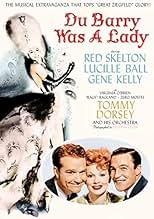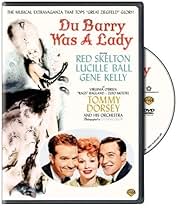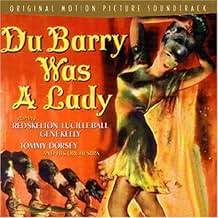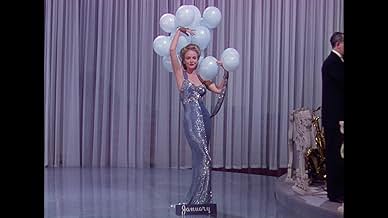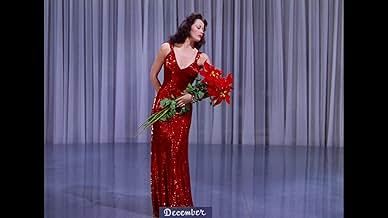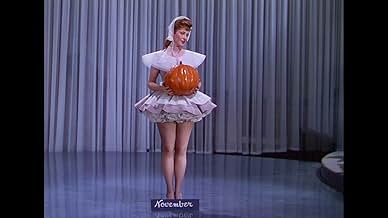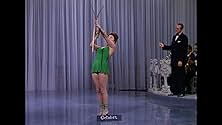VALUTAZIONE IMDb
6,2/10
1837
LA TUA VALUTAZIONE
Aggiungi una trama nella tua linguaA nightclub's coatroom attendant who's in love with the club's singer accidentally sips a drugged drink that makes him dream he's French King Louis XV, courting the infamous Madame Du Barry.A nightclub's coatroom attendant who's in love with the club's singer accidentally sips a drugged drink that makes him dream he's French King Louis XV, courting the infamous Madame Du Barry.A nightclub's coatroom attendant who's in love with the club's singer accidentally sips a drugged drink that makes him dream he's French King Louis XV, courting the infamous Madame Du Barry.
- Regia
- Sceneggiatura
- Star
- Premi
- 1 vittoria in totale
Rags Ragland
- Charlie
- (as 'Rags' Ragland)
- …
Richard Ainley
- Marching Rebel Behind King Louis
- (non citato nei titoli originali)
Grace Albertson
- Perfume Girl
- (non citato nei titoli originali)
Kay Aldridge
- Mrs. McGowan
- (non citato nei titoli originali)
Ernie Alexander
- Delivery Man with Flowers
- (non citato nei titoli originali)
Richard Alexander
- Marching Rebel Behind King Louis
- (non citato nei titoli originali)
Recensioni in evidenza
When MGM bought the rights to Cole Porter's DuBarry Was A Lady for the Arthur Freed unit as per usual the naughty Porter score was completely emasculated and songs old and new from a variety of sources were interpolated into the film. It was like his lyric of Friendship, a perfect blendship.
If you're attentive however you can hear at least two of the songs played as background music, When Love Beckoned and Well Did You Evah which was later interpolated by MGM into High Society for that never to be forgotten duet with Bing Crosby and Frank Sinatra. Only Friendship, Do I Love You Do I and Katie Went To Haiti made the final cut in the score.
Sad also that Ethel Merman and Bert Lahr did not get to repeat the roles they did on Broadway and Darryl Zanuck would not let Betty Grable come over from 20th Century Fox. Ethel only did two of her Broadway roles for the movies, Call Me Madam and Anything Goes and Lahr for whatever reason after the Cowardly Lion from The Wizard Of Oz was given a whole of mediocre parts.
It was said that Merman was not film box office, but certainly Lucille Ball wasn't either at that time. Red Skelton was however, his career was on the rise and so television's two most famous redheads got to team on the big screen.
Lucy is the star of a nightclub chorus and Red is the hat check man who hits the lottery. He's been crushing out on Lucy for forever, but now that he's rich he thinks she might give him a second look. He puts the big moves on her. but she can only see hoofer Gene Kelly. Still his money is tantalizing.
When Red tries to slip Gene a mickey finn he winds up drinking it himself and dreams he's back in the court of Louis XV as Louis XV with Lucy as the notorious Madame DuBarry. And Kelly turns up as the dashing rebel the Black Arrow, rival for the affections of the Madame.
In both the modern and period story MGM packed a lot of entertainment in the 89 minute running time. What court or nightclub would not like to have Tommy Dorsey and his Orchestra as its personal band? There are some nice solos by drummer Buddy Rich and singing with the Pied Pipers are Jo Stafford and newly arrived vocalist Dick Haymes.
Virginia O'Brien contributes a few numbers. She never did any acting roles of note, but was always welcome in an MGM production for her singing and devastating dead pan delivery of a song. Making his big screen debut as the nightclub fortune teller was Zero Mostel with just a trace of his zaniness in play.
This was one of the few films that Gene Kelly was in that he really did not have control of his material yet. Nevertheless his Black Arrow persona was a hint of what you saw later in a high flying dance number in Anchors Aweigh and in The Three Musketeers and The Pirate.
A thin plot is just an excuse to hang a lot of comedy and musical entertainment. But what I would have given to see Merman and Lahr do a faithful adaption on screen.
If you're attentive however you can hear at least two of the songs played as background music, When Love Beckoned and Well Did You Evah which was later interpolated by MGM into High Society for that never to be forgotten duet with Bing Crosby and Frank Sinatra. Only Friendship, Do I Love You Do I and Katie Went To Haiti made the final cut in the score.
Sad also that Ethel Merman and Bert Lahr did not get to repeat the roles they did on Broadway and Darryl Zanuck would not let Betty Grable come over from 20th Century Fox. Ethel only did two of her Broadway roles for the movies, Call Me Madam and Anything Goes and Lahr for whatever reason after the Cowardly Lion from The Wizard Of Oz was given a whole of mediocre parts.
It was said that Merman was not film box office, but certainly Lucille Ball wasn't either at that time. Red Skelton was however, his career was on the rise and so television's two most famous redheads got to team on the big screen.
Lucy is the star of a nightclub chorus and Red is the hat check man who hits the lottery. He's been crushing out on Lucy for forever, but now that he's rich he thinks she might give him a second look. He puts the big moves on her. but she can only see hoofer Gene Kelly. Still his money is tantalizing.
When Red tries to slip Gene a mickey finn he winds up drinking it himself and dreams he's back in the court of Louis XV as Louis XV with Lucy as the notorious Madame DuBarry. And Kelly turns up as the dashing rebel the Black Arrow, rival for the affections of the Madame.
In both the modern and period story MGM packed a lot of entertainment in the 89 minute running time. What court or nightclub would not like to have Tommy Dorsey and his Orchestra as its personal band? There are some nice solos by drummer Buddy Rich and singing with the Pied Pipers are Jo Stafford and newly arrived vocalist Dick Haymes.
Virginia O'Brien contributes a few numbers. She never did any acting roles of note, but was always welcome in an MGM production for her singing and devastating dead pan delivery of a song. Making his big screen debut as the nightclub fortune teller was Zero Mostel with just a trace of his zaniness in play.
This was one of the few films that Gene Kelly was in that he really did not have control of his material yet. Nevertheless his Black Arrow persona was a hint of what you saw later in a high flying dance number in Anchors Aweigh and in The Three Musketeers and The Pirate.
A thin plot is just an excuse to hang a lot of comedy and musical entertainment. But what I would have given to see Merman and Lahr do a faithful adaption on screen.
The movie was slow action. At points, almost boring. But for someone who wants to see up-coming and major stars of this time period, this movie has many. From Ball, Skelton, Kelly, and even O'Brien, Mostel, and finally Tommy Dorsey and his band, this movie has the stars. A good sample of their earlier works.
This film is best-appreciated if seen as a series of skits and songs, a vehicle for the actors. It provides a chance to see Lucille Ball, Red Skelton, Virginia O'Brien and Zero Mostel in comedic action. Gene Kelly only does one solo dance number, but his agility as The Black Arrow foreshadows greater roles like that of D'Artagnan. And seeing Tommy Dorsey dressed up and dancing (or trying to) with the rest of the cast is delightful! There are funny parts as well as parts that presume themselves funny and come off as annoying, but the movie is fun to watch if you don't expect it to be a masterpiece.
Now don't get me wrong, `Dubarry Was A Lady' Is not the best Movie Musical I 've ever seen, but it is one of the prettiest. I can't figure out how they where able to achieve such a creamy coloration in the film but the rich pastels used on the sets and costumes are just stunning. There are some wonderful big band numbers with Tommy Dorsey and his orchestra, featuring Dick Haymes. And a campy `Salmome' number by Virginia O'Brien. Gene Kelly looks great and does one nice dance routine, but he mostly sits around mooning over Lucille Ball. Speaking of Lucille Ball, this was her big debut at MGM, and MGM's first full Techincolor musical, and she looks incredible! Her firey red hair and trim figure were perfectly set off by the contemporary costumes, and she looks great in the powdered wigs too!
Give it a look!
Give it a look!
The Roy Del Ruth directed romp "Du Barry Was Lady" from 1943 I suggest is one of the most imitated of all cinematic musicals. Its sincere main storyline involving dancer lovestruck Gene Kelly with gorgeous Lucille Ball and funnnyman Red Skelton with Virginia O'Brien is solidly presented. But this Sam Goldwyn style extravagance then blossoms out to include an extended dream-fantasy sequence. The later frenetic pageant stars all the characters in a royal French misadventure with Kelly as a rebel against the corrupt King, Ball as the infamous Du Barry who falls for the handsome "Black Arrow", her chief enemy, and Red Skelton as the dreamer and inept french King Louis XV. The immense cast also includes Rags Ragland, an early Zero Mostel as the Swami, powerful Douglass Dumbrille as Kelly's rival, Donald Meek, George Givot, talented actress Louise Beavers as a lovable but bossy maid, Niagara, and the Tommy Dorsey orchestra with the Pied Pipers, at this time including Dick Haymes and Jo Stafford, plus the Goldwyn Girls. The script for this expensive and lovely musical excuse for two hours' entertainment was supplied from a play by Herbert Fields and Buddy DeSylva, adapted by Nancy Hamilton. the screenplay was provided by Irving Brecher, with additional dialogue by Wilkie Mahoney. If the viewer looks closely, one can perhaps spot Marilyn Maxwell as a Goldwyn Girl, Ava Gardner (somwhere in the background), and fine actors Emory Parnell, Kay Aldridge and Grace Albertson in bit parts. Dorsey's orchestra is given several fine numbers, featuring his many talented sidemen. But the film belongs to the Kelly-Ball mismatch and to Red Skelton, being pursued by O'Brien. The producer was Arthur Freed, who employed Karl Freund's lucid cinematography, memorable art direction of the great Cedric Gibbons, Edmund Willis's elaborate set decorations done with Henry Grace, Gile Steel's male costumes and lovely female counterparts designed by Irene Sharaff, Sydney Guilaroff's difficult hair styles and Jack Dawn's inspired makeup. Music I suggest dominates much of the film; so, mention should be made of the orchestrations by Leo Arnaud and Axel Stordahl, done with George Bassman and music adaptor Roger Edens. Sy Oliver was also involved in orchestrations along with musical director George E. Stoll. Charles Waters is credited with the choreography, including several very fine production numbers. After not having seen the film for many years, I found its theatrical basis only a bit confining--the entire main film takes place in a large nightclub the performances more than adequate and the technicolor of this production absolutely lovely. Ball is much better in the French dream sequence I judge than in the more dramatic central plot; Kelly and Skelton acquit themselves very winningly; and Dumbrille and Mostel dominate every scene they are allowed to play. This can be a most enjoyable film, I suggest, for those in the mood for pure entertainment with a stronger story line than is usual for such 1930s and 1940s extravaganzas staged by Hollywood's studio tsars.
Lo sapevi?
- QuizMGM hairstylist Sydney Guilaroff dyed Lucille Ball's hair flame red for this film, the color that she kept for the rest of her life and became her trademark.
- BlooperDuring the scene in Madame Du Barry's boudoir when King Louis XV is chasing Du Barry around the dressing table, a man sitting in a chair can be seen reflected in the mirror.
- Curiosità sui creditiThe Three Oxford Boys are credited orally by the MC ('Gene Kelly') as The Oxford Boys.
- Versioni alternativeThis film was published in Italy in an DVD anthology entitled "Cover Girl", distributed by DNA Srl. The film has been re-edited with the contribution of the film history scholar Riccardo Cusin . This version is also available in streaming on some platforms.
- ConnessioniEdited into American Masters: Gene Kelly: Anatomy of a Dancer (2002)
- Colonne sonoreDu Barry Was a Lady
(1943)
Music by Burton Lane
Lyrics by Ralph Freed
Played during the opening credits
Sung by Lucille Ball (dubbed by Martha Mears) and chorus at the nightclub
I più visti
Accedi per valutare e creare un elenco di titoli salvati per ottenere consigli personalizzati
Dettagli
- Data di uscita
- Paese di origine
- Lingua
- Celebre anche come
- La Dubarry era una dama
- Luoghi delle riprese
- Azienda produttrice
- Vedi altri crediti dell’azienda su IMDbPro
Botteghino
- Budget
- 1.239.222 USD (previsto)
- Tempo di esecuzione1 ora 41 minuti
- Proporzioni
- 1.33 : 1
Contribuisci a questa pagina
Suggerisci una modifica o aggiungi i contenuti mancanti


